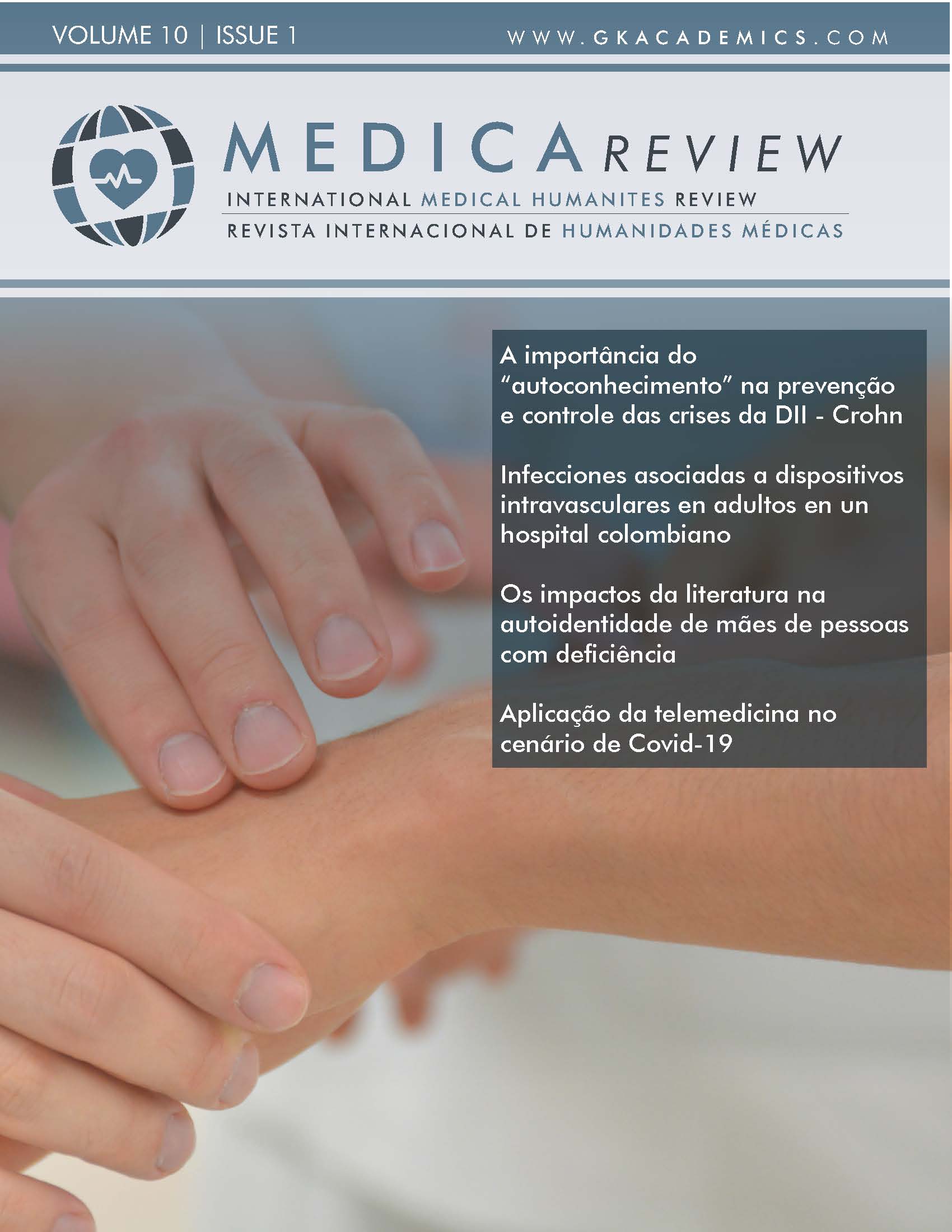Oculomotor Nerve Paralysis in a Patient with Thrombocytopenic Purpura and Antiphospholipid Syndrome
DOI:
https://doi.org/10.37467/gkarevmedica.v10.3120Keywords:
Headache, Antiphospholipid Syndrome, Nerve palsy oculomotor, Purple idiopathic thrombocytopeniaAbstract
We describe the case of a patient with idiopathic thrombocytopenic purpura refractory to treatment, who was admitted due to headache, exotropia of the right eye, palpebral ptosis, severe thrombocytopenia, requiring transfusion. A contrasted brain MRI was performed which revealed subarachnoid hemorrhage in the right frontal operculum, requiring a negative infectious, deficiency, autoimmunity and vasculitic profile, with a profile for positive antiphospholipid syndrome. Vasa nervorum thrombosis was considered a possible pathophysiological mechanism, which favored incomplete oculomotor cranial nerve palsy. Anticoagulation with warfarin was started, immunomodulatory therapy was adjusted for the underlying disease, with favorable evolution on the part of the patient.
Global Statistics ℹ️
|
148
Views
|
55
Downloads
|
|
203
Total
|
|
References
Agostinis, C. B., Bek, A., Bulla, R., Grossi, C., Borghi, M., Meroni, P., & Tedesco, F. (2011). In Vivo Distribution of β2 Glycoprotein I under Various Pathophysiologic Conditions. Blood, 118(15), 4231–4238. doi:10.1182/blood-2011-01-333617
Ali NAM, Tajunisah, I., Subrayan, V., Reddy, S.C., & Goh, KJ. (2008). Antiphospholipid Syndrome Manifesting as Papilledema. Int J Ophthalmol, 1, 277–280.
Álvarez, J., Ardila, M., Urrego, T. y Jaramillo, D. (2021). Síndrome antifosfolípido no trombótico: manifestaciones. Iatreia, 34(4), 347-55. doi:10.17533/udea.iatreia.108
Andreoli, L., Chighizola, C., Banzato, A., Pons, G., Ramire, G. y Erkan, D. (2013). Frecuencia estimada de anticuerpos antifosfolípidos en pacientes con morbilidad del embarazo, accidente cerebrovascular, infarto de miocardio y trombosis venosa profunda: una revisión crítica de la literatura. Artritis Care Res, 65, 1869-73. doi:10.1002 / acr.22066
Arachchillage, D., Efthymiou, M., Mackie, I., Lawrie, A., Machin, S., & Cohen, H. (2014). Anti-protein C Antibodies are Associated with Resistance to Endogenous Protein C Activation and a Severe Thrombotic Phenotype in Antiphospholipid Syndrome. Journal of Thrombosis and Haemostasis : JTH, 12(11), 1801–1809. doi:10.1111/jth.12722
Bancsi, L., van der Linden, I., & Bertina, R. (1992). Beta 2-glycoprotein I Deficiency and the Risk of Thrombosis. Thrombosis and Haemostasis, 67(6), 649–653.
Breen, K., Seed, P., Parmar, K., Moore, G., Stuart-Smith, S., & Hunt, B. (2012). Complement Activation in Patients with Isolated Antiphospholipid Antibodies or Primary Antiphospholipid Syndrome. Thrombosis and Haemostasis, 107(3), 423–429. doi:10.1160/TH11-08-0554
Calvo, I. (2002). Síndrome antifosfolípido. Reumatología, 85-94. https://www.aeped.es/sites/default/files/documentos/14-antifosfolipido.pdf
Cervera, R. (2010). Estrategias terapéuticas en el síndrome antifosfolipídico. Reumatología Clínica, 6(1), 37–42. doi:10.1016/j.reuma.2008.11.020
Cervera, R., & Espinosa, G. (2018). Antiphospholipid Syndrome. Medicina Interna, 25(4), 303-308. https://doi.org/10.24950/rspmi/revisao/4/2018
Cervera, R., Serrano, R., Pons, G., Ceberio, L., Shoenfeld, Y., & de Ramón, E. (2015). Morbidity and Mortality in the Antiphospholipid Syndrome during a 10-year Period: a Multicentre Prospective Study of 1000 Patients. Annals of the Rheumatic Diseases, 74(6), 1011–1018. doi:10.1136/annrheumdis-2013-204838
Champion, BL., Choy, F., Schrieber, L., Roche, J., & Rowe, DB. (2002). Isolated Fascicular Oculomotor Nerve Palsy as the Initial Presentation of the Antiphospholipid Syndrome. J Clin Neurosci, 9, 691–694.
Dey, M., Charles Bates, A., & McMillan, P. (2013). Superior Ophthalmic Vein Thrombosis as an Initial Manifestation of Antiphospholipid Syndrome. Orbit, 32, 42–44.
Espinosa, G., & Cervera, R. (2008). Antiphospholipid Syndrome. Arthritis Research and Therapy, 230.
Forastiero, R. y Martinuzzo, M. (2006). Acción de los anticuerpos antifosfolípidos sobre los mecanismos inhibitorios del factor X activado. Posible mecanismo fisiopatológico del síndrome antifosfolípido. Acta Bioquímica Clínica Latinoamericana, 307-315. https://www.redalyc.org/articulo.oa?id=53540305
Franco, A., Medina, F., Balbi, G., Levy, R. A., & Signorelli, F. (2020). Ophthalmologic Manifestations in Primary Antiphospholipid Syndrome Patients: A Cross-sectional Analysis of a Primary Antiphospholipid Syndrome Cohort (APS-Rio) and Systematic Review of the Literature. Lupus, 29(12), 1528–1543. https://doi.org/10.1177/0961203320949667
Garcia, D., & Erkan, D. (2018). Diagnosis and Management of the Antiphospholipid Syndrome. The New England journal of medicine, 378(21), 2010–2021. doi:10.1056/NEJMra1705454
Giorgi, D., Gabrieli, CB., & Bonomo, L. (1998). The Clinico-ophthalmological Spectrum of Antiphospholipid Syndrome. Ocul Immunol Inflamm, 6, 269-273.
Girón, J. A., García del Río, E., Rodríguez, C., Rodríguez, J., & Serrano, A. (2004). Antiphospholipid Syndrome and Asymptomatic Carriers of Antiphospholipid Antibody: Prospective Analysis of 404 Individuals. The Journal of Rheumatology, 31(8), 1560–1567.
Gropp, K., Weber, N., Reuter, M., Micklisch, S., Kopka, I., Hallström, T., & Skerka, C. (2011). β₂-glycoprotein I, the Major Target in Antiphospholipid Syndrome, is a Special Human Complement Regulator. Blood, 118(10), 2774–2783. doi:10.1182/blood-2011-02-339564
Hoppensteadt, D., Fabbrini, N., Bick, R., Messmore, H., Adiguzel, C., & Fareed, J. (2008). Laboratory Evaluation of the Antiphospholipid Syndrome. Hematology/Oncology Clinics of North America, 22(1), 19. doi:10.1016/j.hoc.2007.10.009
Ibáñez, S., Iruretagoyena, M. y Gutiérrez, M. (2013). Nuevas estrategias en el tratamiento del síndrome antifosfolípido. Revista médica de Chile, 141(8), 1041-1048. doi:10.4067/S0034-98872013000800011
Leal, D., Zubiaurre, V., Danza, A. y Stevenazzi, M. (2021). Síndrome antifosfolipídico obstétrico. Revista Uruguaya de Medicina Interna, 6(2), 36-46. doi:10.26445/06.02.5
Liestøl, S., Sandset, P., Jacobsen, E., Mowinckel, M., & Wisløff, F. (2007). Decreased Anticoagulant Response to Tissue Factor Pathway Inhibitor Type 1 in Plasmas from Patients with Lupus Anticoagulants. British Journal of Haematology, 136(1), 131–137. doi:10.1111/j.1365-2141.2006.06385.x
Lirola, M. y Camacho, M. (2020). Síndrome antifosfolípido. Protoc diagn ter pediatr, 2, 141-154. https://www.aeped.es/sites/default/files/documentos/12_sind_antifosfolipido.pdf
Macías, J., Barco, N. y Barreda, F. (2012). Trombofilia y síndrome antifosfolipídico: a propósito de un caso. Revista Médico-Científica "Luz y Vida", 3(1), 56-60. https://www.redalyc.org/pdf/3250/325028226012.pdf
Miyakis, S., Lockshin, M., Atsumi, T., Branch, D., Brey, R., Cervera, R., & Krilis, S. A. (2006). International Consensus Statement on an Update of the Classification Criteria for Definite Antiphospholipid Syndrome (APS). Journal of Thrombosis and Haemostasis : JTH, 4(4), 295–306. doi:10.1111/j.1538-7836.2006.01753.x
Núñez, C. y Cabiedes, J. (2011). Mecanismos patogénicos de los anticuerpos antifosfolípidos. Reumatol Clin, 7(1), 72–76. doi:10.1016/j.reuma.2009.10.005
Oku, K., Amengual, O., Hisada, R. O., Nakagawa, I., Watanabe, T., Bohgaki, T., & Atsumi, T. (2016). Autoantibodies against a Complement Component 1 q Subcomponent Contribute to Complement Activation and Recurrent Thrombosis/Pregnancy Morbidity in Anti-phospholipid Syndrome. Rheumatology (Oxford, England), 55(8), 1403–1411. doi:10.1093/rheumatology/kew196
Pengo, V., Testa, S., Martinelli, I., Ghirarduzzi, A., Legnani, C., Gresele, P., & Ruffatti, A. (2015). Incidence of a First Thromboembolic Event in Carriers of Isolated Lupus Anticoagulant. Thrombosis Research, 135(1), 46–49. doi:10.1016/j.thromres.2014.10.013
Petri, M. (2000). Epidemiology of the Antiphospholipid Antibody Syndrome. Journal of Autoimmunity, 15(2), 145-151. doi:10.1006/jaut.2000.0409
Pras, E., Neumann, R., Zandman-Goddard, G., Levy, Y., Assia, E. I., Shoenfeld, Y., & Langevitz, P. (2004). Intraocular Inflammation in Autoimmune Diseases. Semin Arthritis Rheum, 34(3), 602–9.
Ricarte, I., Dutra, L., Abrantes, F., Toso, F., Barsottini, O., Silva, G., & Andrade, D. (2018). Neurologic Manifestations of Antiphospholipid Syndrome. Lupus, 27(9), 1404–1414. doi:10.1177/0961203318776110
Ruiz, O., Guerrero, M., Montenegro, C., Díaz, D., Delgado, C. y Marangoni, M. (2011). Prevalencia de anticuerpos antifosfolípidos en pacientes con conectivopatías. Anales de la Facultad de Medicina, 72(3), 187-190. http://www.scielo.org.pe/scielo.php?script=sci_arttext&pid=S1025-55832011000300006&lng=es&tlng=es
Sanna G, D.C.¸ Ruz, D., & Cuadrado, M.J. (2006). Cerebral Manifestations in the Antiphospholipid (Hughes) Syndrome. Rheum Dis Clin North Am, 32, 465–90
Shin, S.Y., & Lee, J.M. (2006). A case of Multiple Cranial Nerve Palsies as the Initial Ophthalmic Presentation of Antiphospholipid Syndrome. Korean J Ophthalmol, 20, 76e8.
Suvajac, G., Stojanovich, L., & Milenkovich, S. (2007). Ocular Manifestations in Antiphospholipid Syndrome. Autoimmun Rev, 6, 409–14.
Tamhankar, M. A., Biousse, V., Ying, G. S., Prasad, S., Subramanian, P. S., Lee, M. S., Eggenberger, E., Moss, H. E., Pineles, S., Bennett, J., Osborne, B., Volpe, N. J., Liu, G. T., Bruce, B. B., Newman, N. J., Galetta, S. L., & Balcer, L. J. (2013). Isolated Third, Fourth, and Sixth Cranial Nerve Palsies from Presumed Microvascular Versus Other Causes: a Prospective Study. Ophthalmology, 120(11), 2264–2269. https://doi.org/10.1016/j.ophtha.2013.04.009
Tektonidou, M., Andreoli, L., Limper, M., Amoura, Z., Cervera, R., Costedoat, N., & MM., W. (2019). Recomendaciones EULAR para el manejo del síndrome antifosfolípido en adultos. Anales de las enfermedades reumáticas, 78, 296-1304.
Utz, V. M., & Tang, J. (2011). Ocular Manifestations of the Antiphospholipid Syndrome. The British journal of ophthalmology, 95(4), 454–459. https://doi.org/10.1136/bjo.2010.182857
Downloads
Published
How to Cite
Issue
Section
License
Those authors who publish in this journal accept the following terms:
- Authors will keep the moral right of the work and they will transfer the commercial rights.
- After 1 year from publication, the work shall thereafter be open access online on our website, but will retain copyright.
- In the event that the authors wish to assign an Creative Commons (CC) license, they may request it by writing to administracion@edulab.es









